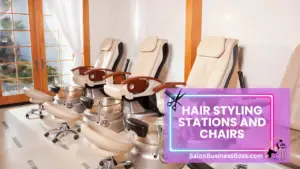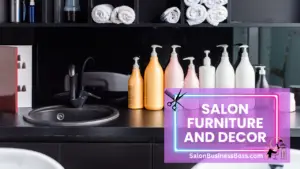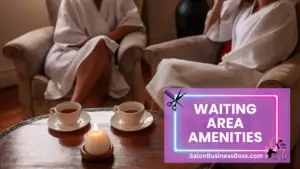Starting a salon business requires careful planning and investment in various essential equipment. From hair styling chairs to hair dryers, each piece of salon equipment plays a crucial role in providing top-notch services to clients. However, acquiring and setting up these tools can be a significant financial undertaking.
Cost of salon equipment estimated to total about $27,000. From styling stations, chairs, and shampoo units to cutting tools, decor, and hair products, starting a salon demands careful budgeting and investment. While this figure may vary based on factors like location and salon size, aspiring salon owners must plan wisely to create a welcoming and fully-equipped space for clients to enjoy top-notch beauty services.
1. Hair Styling Stations and Chairs:

The hair styling stations and chairs form the backbone of any salon, as they are where the magic happens – the transformation of clients’ hair and the creation of new looks. These stations serve as the hub for stylists to work their artistic flair and provide clients with exceptional services. Therefore, it is essential for these stations to strike a perfect balance between comfort, functionality, and aesthetics to ensure a delightful experience for both the professionals and their customers.
The cost of each styling station can vary widely, primarily depending on the brand and features it offers. On average, the price ranges from $1,000 to $2,500, making it a considerable investment for the salon owner. For medium-sized salons, which typically cater to a substantial client base, it is essential to have a sufficient number of stations to accommodate multiple appointments simultaneously and avoid long wait times.
To ensure a seamless workflow and maximize efficiency, a medium-sized salon might require around 6 to 8 styling stations. This would mean an estimated cost ranging from $12,000 to $20,000 for this essential equipment. While the initial expenditure may seem daunting, investing in top-notch styling stations and chairs pays off in the long run by enhancing the overall client experience, creating an inviting ambiance, and providing a favorable environment for stylists to perform their best work.
Given the central role that these stations play in the salon’s success, it is crucial for salon owners to carefully research and select equipment that aligns with their salon’s theme, branding, and overall aesthetic. By striking the right balance between functionality and style, salon owners can set the stage for a memorable and gratifying salon experience, resulting in loyal clientele and increased profitability.
Read more about: Opening a Salon: Elevate Beauty and Pampering
2. Shampoo Units:
Properly installed shampoo units are indispensable for a salon’s success, as they play a crucial role in providing clients with a relaxing and rejuvenating hair wash experience. The shampooing process is often the first step in a salon visit, setting the tone for the entire appointment. Investing in high-quality shampoo units ensures that clients feel pampered and comfortable throughout their visit.
The cost of shampoo units can vary based on factors such as brand, design, and additional features. On average, each unit can range from $800 to $1,500, making it a significant investment for any salon owner. However, this cost is justified by the value it adds to the overall customer experience and the impression it leaves on clients.
For a fully equipped salon, it is advisable to have at least two to four shampoo units. This ensures that there are ample stations available, allowing multiple clients to be serviced simultaneously. With an estimated expense ranging from $1,600 to $6,000 for these units, salon owners need to carefully budget and prioritize their spending to strike the right balance between functionality and aesthetics.
3. Hair Dryers and Hooded Dryers:
High-quality hair dryers and hooded dryers are essential tools that every salon must-have. These devices facilitate efficient hair drying services, ensuring that clients leave the salon with perfectly styled and dry hair. The cost of these dryers can vary significantly, depending on the brand, features, and quality.
Hair dryers, which can cost between $100 to $300 each, offer various heat settings and speed controls to cater to different hair types and styles. Hooded dryers, priced at $200 to $600 each, are especially useful for treatments like deep conditioning and setting hairstyles.
A fully equipped salon typically requires around 6 to 10 hair dryers and 2 to 4 hooded dryers. This results in an estimated expense ranging from $1,200 to $3,000 for hair dryers and $400 to $2,400 for hooded dryers.
While the initial investment may seem substantial, investing in top-notch hair dryers and hooded dryers pays off by providing excellent service to clients, reducing drying time, and enhancing the overall efficiency of salon operations. These essential tools ensure that the salon can cater to clients of various hair types and styles, leaving them satisfied with the results and likely to return for future services.
4. Cutting and Styling Tools:
Cutting and styling tools are the lifeblood of a successful salon. From precision haircuts to intricate hairstyles, having the right set of tools is crucial for stylists to perform their craft with finesse and skill. A well-equipped salon requires a diverse array of cutting and styling tools, including professional-grade scissors, clippers, brushes, and combs.
The cost of these tools can vary based on factors such as the quality of materials, craftsmanship, and brand reputation. On average, investing in a basic set of cutting and styling tools can range from $500 to $1,000. However, salon owners who prioritize excellence and opt for higher-end brands may expect to spend between $2,000 to $4,000 for a comprehensive set.
Despite the initial expense, the value of top-notch cutting and styling tools cannot be overstated. High-quality tools enhance the precision and accuracy of haircuts and hairstyles, resulting in satisfied clients who are likely to become repeat customers. Moreover, investing in durable and long-lasting tools reduces the need for frequent replacements, ultimately saving money in the long run.
5. Salon Furniture and Decor:

Salon furniture and decor play a pivotal role in creating a warm and welcoming atmosphere for clients. The moment clients step into the salon, the ambiance sets the tone for their entire experience. Investing in aesthetically pleasing and comfortable salon furniture enhances the overall client satisfaction and helps build a positive reputation for the salon.
The cost of salon furniture and decor can vary widely, depending on the size of the salon and the design preferences. Key elements of salon furniture include reception desks, waiting area furniture, styling chairs, and styling stations. Additionally, mirrors, lighting fixtures, and decorative elements contribute to the overall ambiance.
On average, outfitting a salon with suitable furniture and decor can range from $3,000 to $8,000. While this may seem like a significant investment, it is a crucial aspect of branding and creating a memorable experience for clients. Selecting furniture that complements the salon’s theme and provides comfort is vital to ensuring that clients feel relaxed and pampered throughout their visit.
Investing in high-quality furniture and decor not only impresses clients but also creates a positive and motivating environment for the stylists. A well-designed salon space encourages creativity and professionalism among the salon staff, leading to a harmonious and productive work environment. Ultimately, the investment in salon furniture and decor yields rewarding returns in the form of client loyalty and positive word-of-mouth referrals.
Read more about: Ready, Set, Equip: Estimating Salon Equipment Costs
6. Hair Products and Supplies:
Hair products and supplies are the lifeblood of a successful salon, as they directly impact the quality of services offered to clients. Stocking up on high-quality products is crucial for meeting client expectations and achieving excellent results. The inventory of hair products typically includes an array of shampoos, conditioners, styling products, hair color, and various treatments tailored to different hair types and needs.
The initial cost of setting up the inventory can vary widely based on the size and focus of the salon. A smaller salon with a more limited product range might have an estimated cost of around $3,000, while larger salons offering an extensive variety of products may require an investment of up to $6,000.
While the upfront cost may seem significant, investing in a diverse and high-quality product inventory is a smart long-term strategy. Satisfied clients who experience the benefits of top-notch products are more likely to become loyal patrons and recommend the salon to others. Regularly replenishing and updating the inventory ensures that clients have access to the latest haircare trends and innovations, keeping the salon competitive in the market.
7. Reception and Point of Sale (POS) System:
A seamless reception and POS system are indispensable components of salon management, facilitating smooth operations and efficient customer service. The reception area is often the first point of contact with clients, and a well-organized system ensures a positive initial impression.
The cost of a reception and POS system can vary based on the complexity and features required. A basic system that handles appointments and sales might cost around $1,000, while more advanced systems that integrate inventory management, customer databases, and analytics can range up to $3,000.
Investing in a reliable reception and POS system streamlines salon processes, reducing waiting times and potential errors in appointment scheduling or payment processing. A modern and efficient system also enables the salon to gather valuable data on client preferences and buying patterns, aiding in targeted marketing strategies and enhancing the overall customer experience.
While the initial cost may seem like an extra expense, the long-term benefits of a well-functioning reception and POS system far outweigh the investment. It ensures a professional and organized front-of-house experience, enabling the salon to deliver exceptional customer service and build a loyal client base.
8. Washroom Facilities:
Maintaining a clean and hygienic washroom is not only a legal requirement for a professional salon but also a reflection of its commitment to providing a positive experience for clients. A well-equipped washroom ensures that clients can freshen up and feel comfortable during their salon visit. The cost of setting up washroom facilities in a salon can vary based on factors such as the size of the washroom and the quality of fixtures and plumbing.
Setting up a basic washroom with standard fixtures and amenities may cost around $1,500. However, investing in higher-end fixtures and additional amenities like air fresheners, hand dryers, and premium soap dispensers can raise the cost to around $3,000.
While the expense may seem relatively small compared to other salon investments, a well-maintained washroom is a vital aspect of the overall client experience. A clean and pleasant washroom conveys professionalism and demonstrates that the salon cares about the well-being and comfort of its clients.
9. Waiting Area Amenities:

The waiting area is the first point of contact for clients, making it an essential space to make a positive impression. Providing amenities that make the waiting experience comfortable and enjoyable can significantly enhance the overall salon visit for clients. Consideration can be given to offering beverages such as water, tea, or coffee, along with a selection of reading materials, magazines, and newspapers to keep clients engaged.
Providing entertainment options like television or music can help clients pass the time while waiting for their appointment. The cost of waiting area amenities may vary based on the level of luxury and the quality of the offerings.
Setting up basic waiting area amenities might cost around $500, while more luxurious amenities and entertainment options can increase the cost to approximately $1,000. This expense is a worthwhile investment as it contributes to the overall client satisfaction and creates a welcoming and customer-centric environment.
Read more about: How Much Does It Cost to Start a Hair Salon Business? (Estimated Startup Costs Included)
Conclusion
Starting a salon business requires significant financial investment, particularly in acquiring the necessary equipment. With an estimated total cost of about $27,000, prospective salon owners can better prepare themselves for the expenses involved. Remember that the figures mentioned above are approximate and can vary based on factors such as location, size of the salon, and brand choices. By carefully budgeting and making informed decisions, aspiring salon entrepreneurs can set themselves up for success and create a welcoming space for clients to indulge in beauty and self-care services.
Frequently Asked Questions

1. How often should I replace salon equipment?
High-quality salon equipment can last for several years, but regular maintenance and replacements might be necessary over time.
2. Can I negotiate prices with suppliers?
Yes, some suppliers might be open to negotiation, especially when purchasing a significant quantity of equipment.
3. Should I invest in salon equipment warranties?
Warranties provide added protection for your investment, ensuring repairs or replacements if any equipment malfunctions.
To learn more on how to start you own salon checkout my startup documents here.
Please note that the contents of this blog are for informational and entertainment purposes only and should not be construed as legal advice. Any action taken based on the information provided in this blog is solely at your own risk. Additionally, all images used in this blog are generated under the CC0 license of Creative Commons, which means they are free to use for any purpose without attribution.

About the author. Entrepreneur and Salon Business Fan.
Hi! I am Shawn and I am a happy individual who happens to be an entrepreneur. I have owned several types of businesses in my life from a coffee shop to an import and export business to an online review business plus a few more and now I create online salon business resources for those interested in starting new ventures. It’s demanding work but I love it. I do it for those passionate about their business and their goals. That’s why when I meet a salon business owner, I see myself. I know how hard the struggle is to retain clients, find good employees and keep the business growing all while trying to stay competitive.
That’s why I created Salon Business Boss: I want to help salon business owners like you build a thriving business that brings you endless joy and supports your ideal lifestyle.


